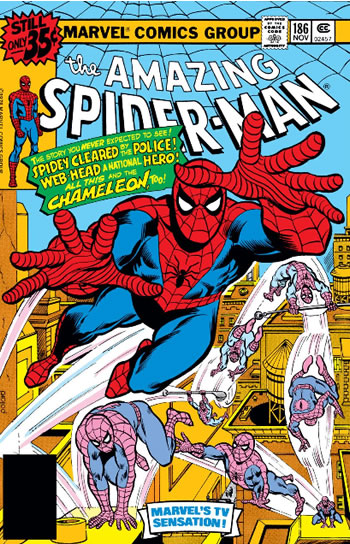 There are many issues of Spider-Man comics that develop the rich history of our favorite hero. We have the famous origin from Amazing Fantasy #15, the “Spider-Man No More” from Amazing Spider-Man #50, “The Night Gwen Stacy Died” in Amazing Spider-Man #121, and of course the all important Superior Spider-Man #2 (first (and only) appearance of the phrase “crazy town banana pants”), but few are as full of historical references to what is going on not only in the world around Spider-Man, but also in the world around comics themselves as Amazing Spider-Man #186.
There are many issues of Spider-Man comics that develop the rich history of our favorite hero. We have the famous origin from Amazing Fantasy #15, the “Spider-Man No More” from Amazing Spider-Man #50, “The Night Gwen Stacy Died” in Amazing Spider-Man #121, and of course the all important Superior Spider-Man #2 (first (and only) appearance of the phrase “crazy town banana pants”), but few are as full of historical references to what is going on not only in the world around Spider-Man, but also in the world around comics themselves as Amazing Spider-Man #186.
What is it about this seemingly insignificant issue that makes it of value to the comic book historian? Well read on, my friends. This issue transcends comics and dabbles in novels, TV, and real world personalities. Best of all, it’s just plain fun to explore.
The Basics: This issue is only worth $15 in NM condition and is easily found on Marvel Unlimited or Essential Spider-Man #5. The cover itself is beautiful with art by Keith Pollard and Gaspar Saladino and is one that you’ve probably seen before even if you’ve never read this comic. Somehow it didn’t make CBR’s 50 Greatest Spider-Man Covers of All Time. The story is written by Marv Wolfman and art is by Keith Pollard and Mike Esposito.
The issue itself is a great standard Spider-Man comic. It is a perfect example of the Silver Age rule that every comic is someone’s first issue. You can easily pick up what is going on, but it is still obvious that there is an ongoing story. It follows Peter Parker’s Graduation issue (the one where he doesn’t) and wraps up a long running story of Spidey vs. the police.

The History: This is what we’re reading the article for, right? So lets get into it. This issue is packed with references to what is going on in the comics world. Even if we didn’t have a publication date of Nov. 1978, we could easily peg it within a few months based on all the allusions. Let’s start with the cover itself. In the bottom corner we have “#Marvel’s TV Sensation!” O.K., so maybe the hashtag doesn’t actually appear, but it would have if published today. At this point we are well into the first season of two seasons for the show and every issue had this blurb on the cover. The show starred Nicholas Hammond and was typical 70s quality and had poor special effects. Despite that, the show is worthy of its own post somewhere in the (distant) future if fans demand it, so I’ll leave you with the teaser to tide you over:
O.K., back it up a bit to reference the clearing of all charges. If you look up Spider-Man summaries, chances are all this issue will have is that Spider-Man is cleared of charges. But what was he wanted for to begin with?
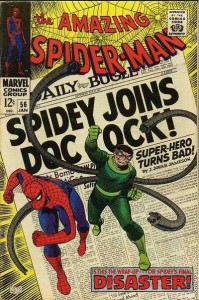 Spider-Man started off breaking the law all the way back in ASM #1 when he breaks into federal property in order to save John Jameson. Not much is done with it except Jameson calling for his arrest. Later, in ASM #13, he is wanted for crimes committed by Mysterio. However, it is not until ASM #56 that things really heat up for him. This is the issue that he joins with Doc Ock to commit crimes (because he has amnesia). However, it really ramps up in ASM #90 with the death of Captain Stacy during Spidey’s fight with Doctor Octopus. That makes sense since Stacy was one of their own. At this point, officers are firing on this masked vigilante. Spider-Man having something to do with the death of outstanding citizen Norman Osborn and Captain Stacy’s daughter in #121 didn’t ease things either. So we can’t really blame the police for wanting to bring him in for questioning, but we also can’t really blame Spider-Man for wanting to stay out of that mess altogether.
Spider-Man started off breaking the law all the way back in ASM #1 when he breaks into federal property in order to save John Jameson. Not much is done with it except Jameson calling for his arrest. Later, in ASM #13, he is wanted for crimes committed by Mysterio. However, it is not until ASM #56 that things really heat up for him. This is the issue that he joins with Doc Ock to commit crimes (because he has amnesia). However, it really ramps up in ASM #90 with the death of Captain Stacy during Spidey’s fight with Doctor Octopus. That makes sense since Stacy was one of their own. At this point, officers are firing on this masked vigilante. Spider-Man having something to do with the death of outstanding citizen Norman Osborn and Captain Stacy’s daughter in #121 didn’t ease things either. So we can’t really blame the police for wanting to bring him in for questioning, but we also can’t really blame Spider-Man for wanting to stay out of that mess altogether.
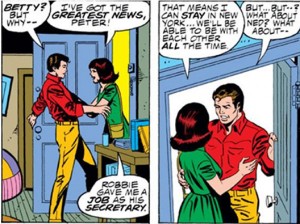 Back to being cleared of crimes later. Peter goes and visits Aunt May in the hospital where he gets reprimanded by a doctor for not having money saved up to take care of her medical expenses. “Kids! They never plan ahead.”
Back to being cleared of crimes later. Peter goes and visits Aunt May in the hospital where he gets reprimanded by a doctor for not having money saved up to take care of her medical expenses. “Kids! They never plan ahead.”
Back at his apartment, Betty Brant pays him a visit and they talk all night long. She is obviously coming on Peter and he, despite being concerned that she is a married woman, is rather liking it. Long time Spidey fans groan when we see passages like this. If you want to know why Peter spending the night talking to Betty Brant is a bad thing, you need to read Bertone Hates Betty.
Once we get past this, the allusions really get rich. Spider-Man confronts DA Tower and learns that he is cleared of all charges. Look at the editorial note in this panel:
That Mayhem in Manhattan note refers to a novel written by Len Wein and Marv Wolfman. The novel itself has gotten mixed reviews. SpiderFan.org has a low opinion, in fact, let me give you their words about it: “This sorry excuse for a novel is right down the scraping end of the literary barrel.” They do give a very summary of the book.
The story has no subplots and centers around a plot Doc Ock has to blackmail all the oil CEOs of America. He is going to make them think he has made their oil radioactive, but they can pay him for replacement oil for a year. The replacement oil is really their oil because it really isn’t tainted. Obviously Spidey stops them and, even though it is missing from this summary (I couldn’t get my hands on a copy of the book myself before time for the article to post), apparently Doc Ock seemingly perishes in the end. While SpiderFan insists that the best thing about the book is the introduction from Stan Lee, I disagree. This panel is the best thing about the book – it now exists in continuity. Today Marvel has its media existing in separate universes, but back when they started it fit right into the story.
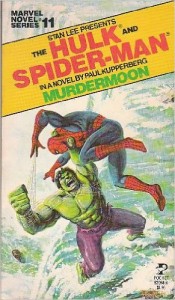 This wasn’t Marvel only novel to come out at this time. For this run they released eleven novels. There were two more that were about Spider-Man, Crime Campaign and Murdermoon, which also featured the Hulk. If any Crawlspacer out there has read any of these books, please rate them in the comments section. You can buy the book for less than two bucks as well as the others on Amazon. You may like it better than SpiderFan. As one Amazon reviewer put it, “This book is for the fans of the 1970s Spiderman [sic]. It is not for people who are ‘brand new day’ fans.”
This wasn’t Marvel only novel to come out at this time. For this run they released eleven novels. There were two more that were about Spider-Man, Crime Campaign and Murdermoon, which also featured the Hulk. If any Crawlspacer out there has read any of these books, please rate them in the comments section. You can buy the book for less than two bucks as well as the others on Amazon. You may like it better than SpiderFan. As one Amazon reviewer put it, “This book is for the fans of the 1970s Spiderman [sic]. It is not for people who are ‘brand new day’ fans.”
Spidey can’t take the pressure of the press conference, so he sets up another one later that evening in the park so he can have more room. This announcement is covered live on TV and the Chameleon sees it as his opportunity to finally get his revenge. No more standing around burning buildings for him – it’s time for action!
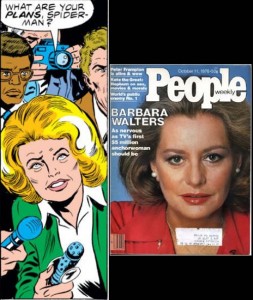 Covering all of this is real world personality Barbara Walters. This also helps to pl
Covering all of this is real world personality Barbara Walters. This also helps to pl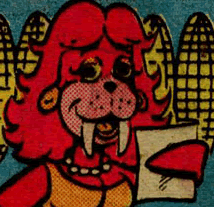 ace this comic in the late 70s. Walters actually
ace this comic in the late 70s. Walters actually
makes several appearances in comics, especially around this time. She also pops up later in a Spider-Ham story (as Barbara Walrus). According to Comic Vine, she appears in 13 different comics, but it didn’t have a list of titles.
It is at this press conference that the real fun stuff happens. First Spider-Man makes it clear that he is a loner and will not be joining the Avengers (too bad he changed his mind on that). Then he starts to get approached by merchandizers. Most of the meetings happen off panel, but we do get to see a guy offer to make him a TV superstar. He turns it down (guess he didn’t read his own cover) because “you’d probably want me to wear a cape of a belt or carry my web shooters in my nose or something.” At this point he makes a plug for Marvel and tells him to sign the Hulk.
 Now, I’m not positive on the origin of the comment on the nose web shooters, but it might something to do with the fact that the producer, Kenneth Johnson, had no real love of the comic book source material. In his words, “We were not that concerned about trying to match the comic book.” He wanted the Hulk to be red to symbolize anger and didn’t think he should be too big (Lou Ferrigno was chosen over Richard Kiel because, as Johnson put it, “Dick’s a little too big.”). Other changes included removing the speaking ability of the Hulk (“Hulk-talk sounds dumb”) and changing the name from Bruce Banner to David Banner because an alliterative name sounded too comic booky because you wouldn’t want a comic book TV show to rely, you know, on the source material. The show had
Now, I’m not positive on the origin of the comment on the nose web shooters, but it might something to do with the fact that the producer, Kenneth Johnson, had no real love of the comic book source material. In his words, “We were not that concerned about trying to match the comic book.” He wanted the Hulk to be red to symbolize anger and didn’t think he should be too big (Lou Ferrigno was chosen over Richard Kiel because, as Johnson put it, “Dick’s a little too big.”). Other changes included removing the speaking ability of the Hulk (“Hulk-talk sounds dumb”) and changing the name from Bruce Banner to David Banner because an alliterative name sounded too comic booky because you wouldn’t want a comic book TV show to rely, you know, on the source material. The show had He is then approached by a comic book executive who wants to pit him in a comic against the heavy weight champion Leon Spinks. Comic book fans will recognize that this is an allusion at DC who put Superman up against Muhammed Ali. It is a rather ridiculous comic (which, by the way, you can read quite a bit of here). Superman gets his rear handed to him by Ali because they find themselves on a different planet which has a red sun and it is up to Ali to save the world by beating the living crap out of an alien boxer. On top of all this, Ali uses his
 detective powers to figure out Superman’s secret identity. The coolest thing about this (besides the wrap around cover featuring all sorts of celebrities both of the real life version and comic version) is that they train in the Nth dimension and you will undoubtedly already be aware that ‘nth’ is the only word in the English language that has no vowels. (What can I say? I was an English major. We find those things interesting. You should see us at parties.)
detective powers to figure out Superman’s secret identity. The coolest thing about this (besides the wrap around cover featuring all sorts of celebrities both of the real life version and comic version) is that they train in the Nth dimension and you will undoubtedly already be aware that ‘nth’ is the only word in the English language that has no vowels. (What can I say? I was an English major. We find those things interesting. You should see us at parties.)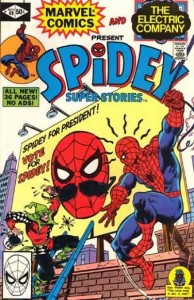 Spidey then tells the girl that he couldn’t sign on anyway since he just gave the rights to a comic book to Electric Company for free. That would be the Spidey Super Stories which were comic book versions of the TV version of Spidey’s appearance on The Electric Company. The TV version deserves a post all to itself and Spidey’s not referencing that here anyway. The comic version ran for a lot longer than the show (from 1974 to 1982). The stories do not fit continuity and are designed to promote reading in young kids (and hook them onto comics as well?). Each comic is approved by Easy Reader (Morgan Freeman on the TV show) as “easy-to-read” (each page was no more than four panels) and often used supporting casts members like Mary Jane and Jameson. Each issue also featured a team up with another Marvel character.
Spidey then tells the girl that he couldn’t sign on anyway since he just gave the rights to a comic book to Electric Company for free. That would be the Spidey Super Stories which were comic book versions of the TV version of Spidey’s appearance on The Electric Company. The TV version deserves a post all to itself and Spidey’s not referencing that here anyway. The comic version ran for a lot longer than the show (from 1974 to 1982). The stories do not fit continuity and are designed to promote reading in young kids (and hook them onto comics as well?). Each comic is approved by Easy Reader (Morgan Freeman on the TV show) as “easy-to-read” (each page was no more than four panels) and often used supporting casts members like Mary Jane and Jameson. Each issue also featured a team up with another Marvel character.
I believe it is this comic that Mary Jane later refers to in Spider-Girl #91 when she explains to May why she opened a Spider-Girl costume shop.
He does ask the comic exec out on a date, but she refuses citing her policy against dating men in masks.
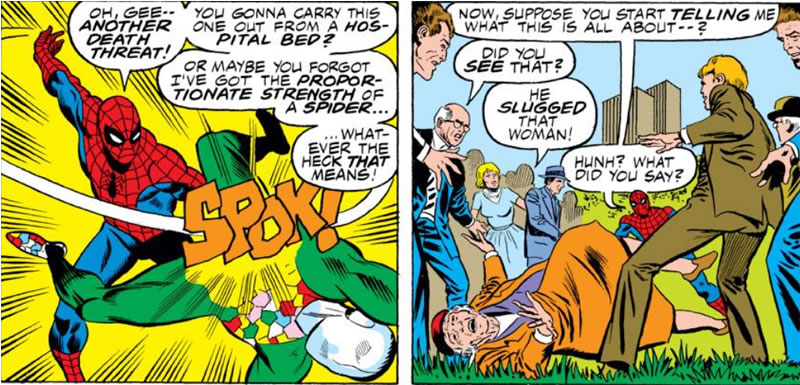 Next in line is a little old lady who wants to but a costume like his for her grandson’s (little Timmy) 35th birthday. Spidey tries to politely brush her off until his spider sense goes bonkers. The old lady melts into the Chameleon, which is a new power, by the way. The Chameleon’s last upgrade was in a Daredevil comic where he could change the clothing easily. This change is from a hologram projected from his belt. Spidey lays the Chameleon out. Cool belt or no, the Chameleon cannot match Spider-man’s strength. Unfortunately for our web head, the belt is still projecting the image of a sweet old lady to EVERYONE ELSE. The TV cameras all capture the shot of Spider-Man pummeling the woman and it seems that his new found positive approval rating is over. Chameleon runs off and later makes himself look like a policeman, so now it looks like Spidey’s beating the snot out of a cop. However, Spider-Man realizes eventually that nobody can see what he sees and figures out that he must rip off the belt to save his reputation. Once doing so, everyone is uncertain until good old Flash Thompson rallies everyone back to Spidey. All the people cheer (well, not Jameson) and carry him off on their shoulders.
Next in line is a little old lady who wants to but a costume like his for her grandson’s (little Timmy) 35th birthday. Spidey tries to politely brush her off until his spider sense goes bonkers. The old lady melts into the Chameleon, which is a new power, by the way. The Chameleon’s last upgrade was in a Daredevil comic where he could change the clothing easily. This change is from a hologram projected from his belt. Spidey lays the Chameleon out. Cool belt or no, the Chameleon cannot match Spider-man’s strength. Unfortunately for our web head, the belt is still projecting the image of a sweet old lady to EVERYONE ELSE. The TV cameras all capture the shot of Spider-Man pummeling the woman and it seems that his new found positive approval rating is over. Chameleon runs off and later makes himself look like a policeman, so now it looks like Spidey’s beating the snot out of a cop. However, Spider-Man realizes eventually that nobody can see what he sees and figures out that he must rip off the belt to save his reputation. Once doing so, everyone is uncertain until good old Flash Thompson rallies everyone back to Spidey. All the people cheer (well, not Jameson) and carry him off on their shoulders.
Cronin, Brian. “When We First Met – First Anti-Spider-Man Daily Bugle Headline and More Spider-Man Firsts!” CBR. Comic Book Resources. 19 Jan. 2014. Web. 7 Sept. 2015.
“Amazing Spider-Man Vol 1 186.” Marvel Database. CC-BY-SA. N.d. Web. 12 Sept. 2015.
“Barbara Walters.” Comic Vine. Game Spot. 2015. Web. 18 Sept. 2015.
“Book 1: Spider-Man, Mayhem in Manhattan.” Spiderfan. ComicBoards. 2003. Web. 17 Sept. 2015.
“Comics: Amazing Spider-Man (Vol 1) (Page 8 of 38).” Spiderfan. ComicBoards. 2013. Web. 12 Sept. 2015.
Diatomaceous. “Classic Len Wein and Marv Wolfman Story.” Amazon. Amazon. 5 Dec. 2009. Web. 17 Sept. 2015.
Hiatt, Brian. “How ‘The Incredible Hulk’ Conquered Seventies TV.” Rolling Stone. Rolling Stone. 1 May 2015. Web. 18 Sept. 2015.
Jlroberson. “Superman Vs. Muhammed Ali.” Scans Daily. N.p. 18 Nov. 2009. Web. 17 Sept. 2015.
Ohitsme, et al. “Chameleon.” Marvel Universe Wiki. Marvel. 2015. Web. 17 Sept. 2015.
Saffel, Steve. Spider-Man the Icon: The Life and Times of a Pop Culture Phenomenon. Titan, London. 2007. Print.
“Superman vs. Muhammed Ali.” Wikipedia. Wikimedia. 16 Sept. 2015. Web. 17 Sept. 2015.
Images:
All images from ASM #186 and Spider-Girl #91 from Marvel Unlimited
The Amazing Spider-Man
TV Promo Poster
ASM #56 cover
Mayhem in Manhattan
Murdermoon
Barbara Walters
David Banner
Spidey Super Stories #49 Cover
Credible Hulk

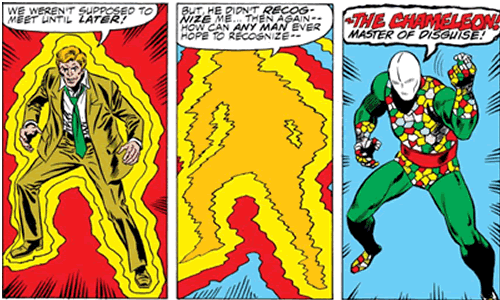
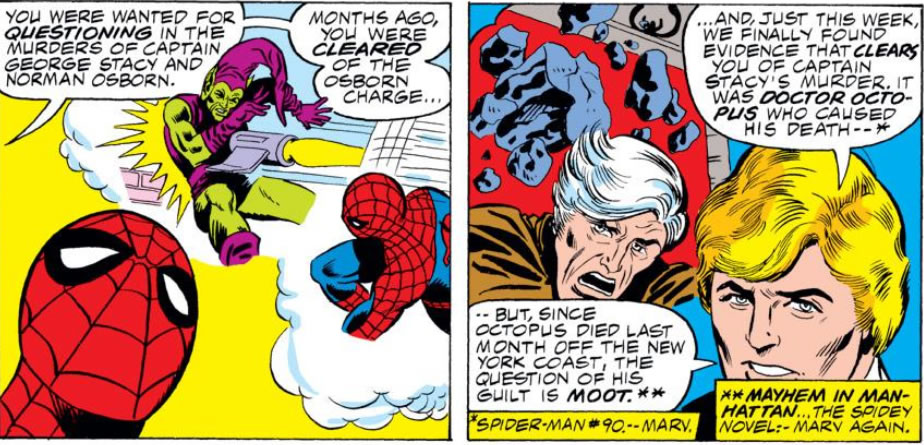
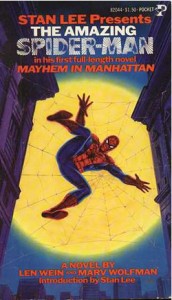
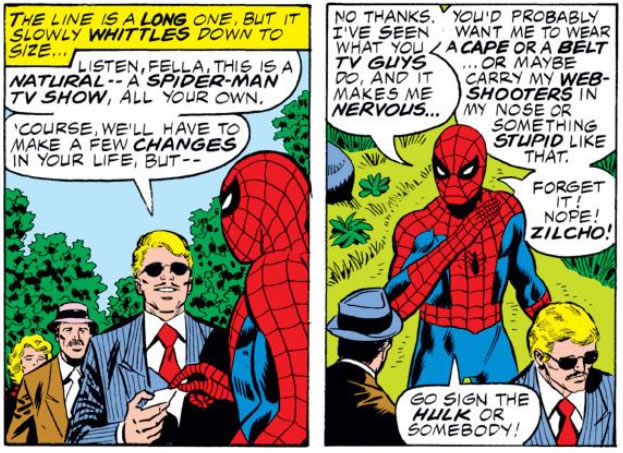
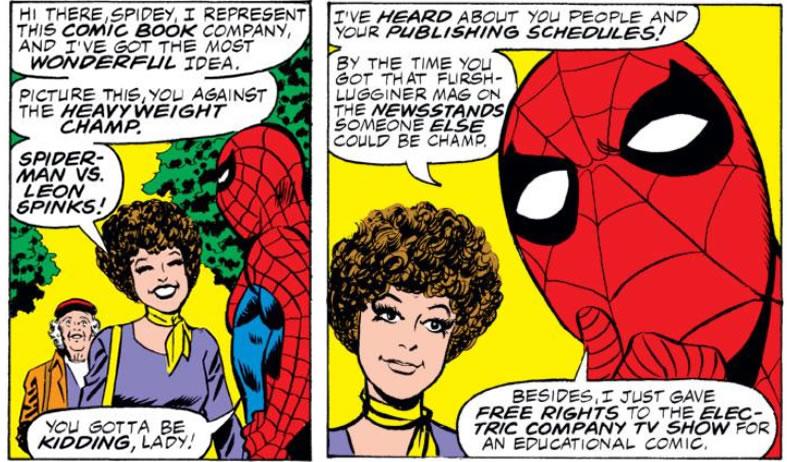
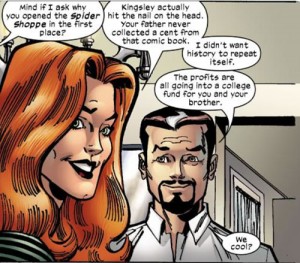
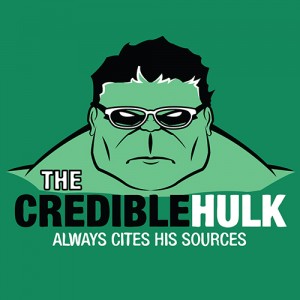
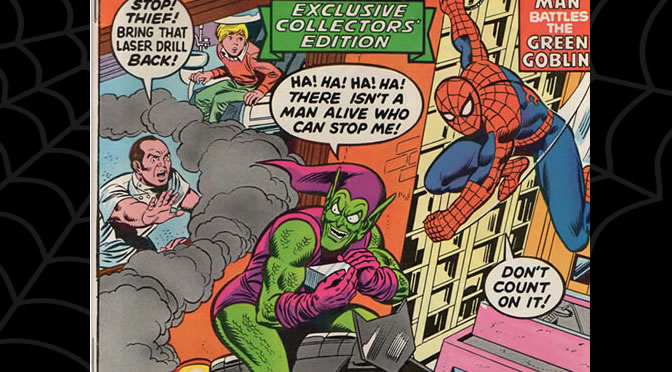






Spidey not an Avenger, never having been married, no multi-racial counterpart from another universe, not rich and Norman dead?! Who is this character anyway?! 😉
Thanks for the recommendation,found great fun in rereading this issue
BD – funny the memories we connect to certain books. The cover of this one came off of mine and used it to wrap around my high school research paper (which, of course, was on comics). Made an A on it if I remember correctly.
PeterParkerfan – Yes, you do! It is a simpler story from a simpler time, but I think it holds up well enough today. Sure, it’s no multi-universe spanning mega event, but it has Spidey doing what Spidey does best (in my opinion).
Tijeans – a pox on my naming! Now Spinks I remember typing in as Sphinx, but when you posted Kenneth instead of Kevin, my thought was, “I put Kenneth!” Then I went back up the article and saw I had indeed put Kevin. I’m going to blame sunspots on that one. The intense radiation they put out must have interfered with the wifi submission of my post, thus slightly changing the molecules enough to turn Kenneth into Kevin. I’m awarding myself a no-prize for that. I might have to get that backpack!
Another great article Mark, thanks. I remember the cover well and it was actually used on a backpack I saw for sale in my LCS – http://www.geekalerts.com/amazing-spiderman-186-cover-backpack/
This column continues to be a great addition to the site.
Just one minor thing, the producer of The Incredible Hulk tv series was Kenneth Johnson, not Kevin. Not sure why I remember that when I barely remember my own name somedays! 🙂
This ASM story looks fun. I gotta check this one out since Never read it before.
Great article as usual. I also have fond memories of this issue too. I loved that cover, but I first saw this cover at my grandpa’s barber. I’d go in and get a hair cut and read this book. The barber noticed I liked it so much he eventually said I could have it. Ahh 1980’s Spidey comics and memories of getting hair cuts. lol
Hornacek, Jeff, Adam, Al, Spider-Dad, and AmFan15 – Glad you guys are enjoying the articles. They sure are a lot of fun to write and even more so when people like them as well. All your comments are appreciated.
Spider-Dad, I wish I could chalk that up to spell check, but I think it has more to do with being a mythology fan and my brain reading it the way it wanted to. Thanks for the check – I’m an English teacher and shouldn’t let stuff like that slip by. I’m going to make the change in the post.
Nice rewind on ASM and makes me feel a bit old. (OK, perhaps I am.) I picked this issue up on a spinner rack when it was released and found the story OK. What I liked most was how it referenced older stories and in retrospect was probably responsible for piquing my interest in ASM in general, since it was only a few months later I picked up ASM #194 and became hooked.
I have the Murdermoon novel sitting right here on my bookshelf. I got it along with other Penguin Publishing Marvel books, which included ASM #1-6, #7-13 and #14-20. Until Marvel Tales started reprinting the older ones in the early ’80’s, this was the only early copies I had of the Lee/Ditko series. As for a review on Murdermoon, since I have not read it in over 35 years, I cannot recall it being good or bad. Funny, I knew exactly where it was on my bookshelf though…
Lastly, it is Leon Spinks, not Sphinx. Chalk that up to spell check?
Yes, I forgot to add it in my comment but I am enjoying these articles too. Well done.
BTW Mark, I am very much enjoying your articles! They are very comprehensive, and I can tell that you put a lot of work into them. Keep up the good work, sir!
I remember Mayhem In Manhattan…In fact, I think I still have it! I don’t really remember all that much about the book, but as I recall, Doc Ock “died” at the end of the book while falling down a shaft of some sort (an elevator or smokestack or something). His tentacles were coated in oil at the time, so he couldn’t grab hold of anything to save himself. It spent too long with the oil people IMO, which I didn’t care about as a kid…I just wanted to read about Spidey and Doc Ock. Still, it was a decent read. Worth picking up, if for no other reason than it was Spidey’s first full-length novel.
This was the first back issue I ever got. Nice to see it covered here.
Great article!
Quick note. It is worth mentioning how in ASM #122 Spider-Man, although being metaphorical, does say outright that he ‘killed’ Gwen Stacy’. I feel this was the moment more than anything else which made Spidey truly wanted.
I always assumed that the comic book the MC2 MJ referenced was the Spider-Man comics published by |Marvel comics within the Marvel universe without Spider-Man’s permission, similar to the Fantastic Four comic book which Reed had to give Stan and Jack ideas for.
This along with ASM #187 was one of my first Spider-man comics as well. Well the first one that wasn’t a Spidey Super Stories anyway. And what a confusing first issue it was!
Right before this, he had a new trick that allowed him to instantly change the look of his clothes, but Daredevil tracked him down by his heartbeat, which led him to this cool, but fashion disaster, outfit. After this, he started taking serums that could change his skin. That’s power upgrade to my knowledge and him reverting back to masks is news to me. I checked out of comics for a little while during BND before picking them back up. Guess I should go back and read those missed issues on Unlimited.
I remember this cover, I know that I read this issue but have little memory of it. It wasn’t until the Stern run where I actually saved the comics I read and started paying attention to continuity (so many lost issues … sigh).
That costume of the Chameleon – hoo-boy! I hope that got replaced real quick. And his hologram-belt, when did they get rid of that? From what I remember, when he appeared in the Micheline run in “The Thief Who Stole Himself” (great crazy title) he described how he had just gained the ability to change his entire appearance at will – up until then he still had to use actual masks. But it came at a cost – he could no longer change back to his own face. Then in BND they reverted him to having to use masks because Mephisto undoing the marriage affected the Chameleon’s powers … right.